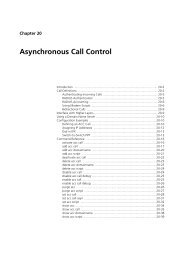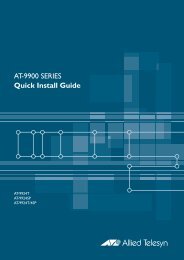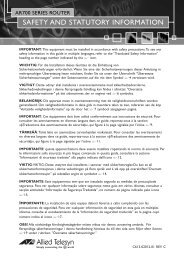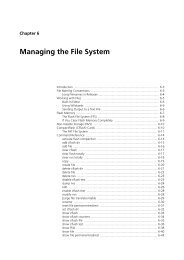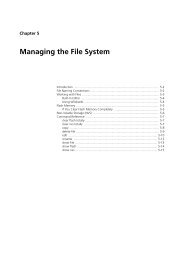Chapter 3: Using the Graphical User Interface (GUI) - Allied Telesis
Chapter 3: Using the Graphical User Interface (GUI) - Allied Telesis
Chapter 3: Using the Graphical User Interface (GUI) - Allied Telesis
Create successful ePaper yourself
Turn your PDF publications into a flip-book with our unique Google optimized e-Paper software.
3-2 <strong>Allied</strong>Ware OS Software Reference<br />
Introduction<br />
You can set up, manage, monitor, and troubleshoot <strong>the</strong> switch using <strong>the</strong><br />
command line interface (CLI) or <strong>the</strong> web-based <strong>GUI</strong>. The <strong>GUI</strong> includes <strong>the</strong><br />
commonly-required functions for a number of protocols. You can access <strong>the</strong><br />
<strong>GUI</strong> using HTTP, for local or remote access or HTTPS, for secure remote access<br />
This section describes <strong>the</strong> basic functionality of <strong>the</strong> <strong>GUI</strong>, including:<br />
■ What is <strong>the</strong> <strong>GUI</strong>?<br />
• an introduction to <strong>the</strong> <strong>Graphical</strong> <strong>User</strong> <strong>Interface</strong><br />
■ Accessing <strong>the</strong> switch via <strong>the</strong> <strong>GUI</strong>:<br />
browser and PC setup, including interaction with HTTP proxy servers<br />
establishing a connection to your switch, including information about<br />
configuring SSL for secure access<br />
<strong>the</strong> System Status page, <strong>the</strong> first <strong>GUI</strong> page you see<br />
diagnosing and solving connection problems<br />
■ <strong>Using</strong> <strong>the</strong> <strong>GUI</strong>: navigation and features:<br />
an overview of <strong>the</strong> menus<br />
using configuration pages, with a description of key elements of <strong>GUI</strong><br />
pages<br />
combining <strong>GUI</strong> and CLI configuration<br />
See <strong>Chapter</strong> 1, Getting Started for information about<br />
■ changing your password<br />
■ using <strong>the</strong> context sensitive online help<br />
■ saving your configuration<br />
What is <strong>the</strong> <strong>GUI</strong>?<br />
The <strong>GUI</strong> (<strong>Graphical</strong> <strong>User</strong> <strong>Interface</strong>) is a web-based device management tool<br />
designed to make it easier to configure and monitor <strong>the</strong> switch. The <strong>GUI</strong><br />
provides an alternative to <strong>the</strong> CLI (Command Line <strong>Interface</strong>). Its purpose is to<br />
make complicated tasks simpler and regularly performed tasks quicker.<br />
The <strong>GUI</strong> relies on an HTTP server that runs on <strong>the</strong> switch, and a web browser<br />
on <strong>the</strong> host PC. When you use <strong>the</strong> <strong>GUI</strong> to configure <strong>the</strong> switch, <strong>the</strong> <strong>GUI</strong> sends<br />
commands to <strong>the</strong> switch and <strong>the</strong> switch sends <strong>the</strong> results back to your browser,<br />
all via HTTP.<br />
The tasks you may perform using <strong>the</strong> <strong>GUI</strong> are not as comprehensive as <strong>the</strong><br />
command set available on <strong>the</strong> CLI, but for some protocols, a few clicks of <strong>the</strong><br />
mouse are adequate.<br />
The <strong>GUI</strong> is stored on <strong>the</strong> switch as an embedded resource file, with <strong>the</strong> .rsc file<br />
extension. Resource files are model-specific, with <strong>the</strong> model and version<br />
encoded in <strong>the</strong> file name.<br />
Software Version 2.9.1/3.2.1<br />
C613-03130-00 REV A



